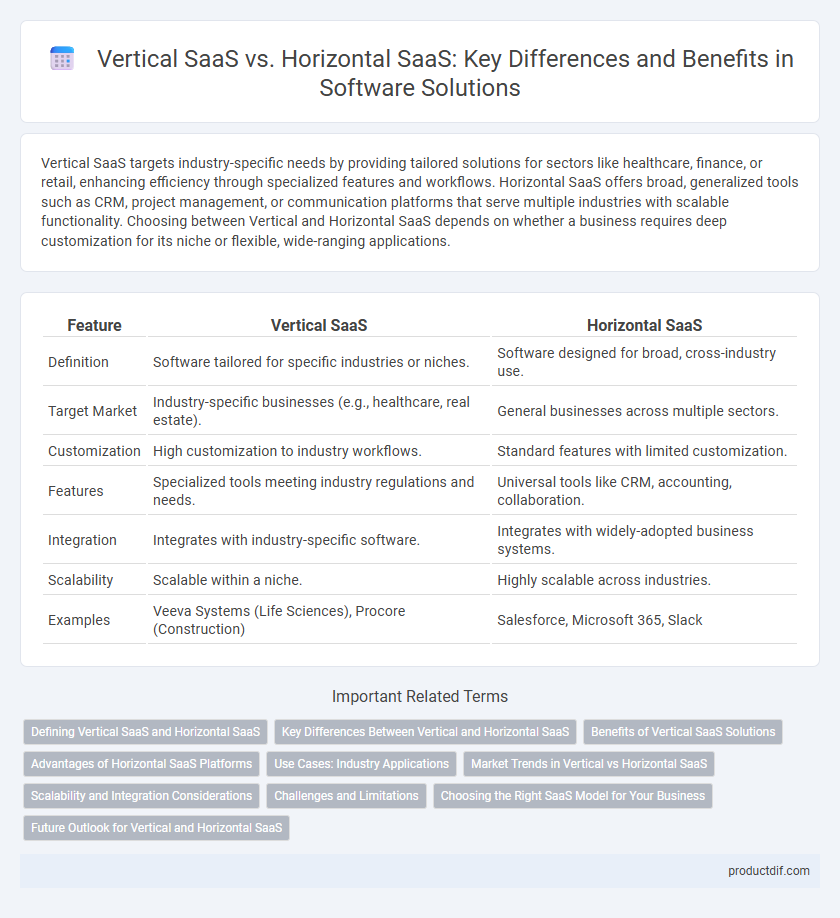Vertical SaaS targets industry-specific needs by providing tailored solutions for sectors like healthcare, finance, or retail, enhancing efficiency through specialized features and workflows. Horizontal SaaS offers broad, generalized tools such as CRM, project management, or communication platforms that serve multiple industries with scalable functionality. Choosing between Vertical and Horizontal SaaS depends on whether a business requires deep customization for its niche or flexible, wide-ranging applications.
Table of Comparison
| Feature | Vertical SaaS | Horizontal SaaS |
|---|---|---|
| Definition | Software tailored for specific industries or niches. | Software designed for broad, cross-industry use. |
| Target Market | Industry-specific businesses (e.g., healthcare, real estate). | General businesses across multiple sectors. |
| Customization | High customization to industry workflows. | Standard features with limited customization. |
| Features | Specialized tools meeting industry regulations and needs. | Universal tools like CRM, accounting, collaboration. |
| Integration | Integrates with industry-specific software. | Integrates with widely-adopted business systems. |
| Scalability | Scalable within a niche. | Highly scalable across industries. |
| Examples | Veeva Systems (Life Sciences), Procore (Construction) | Salesforce, Microsoft 365, Slack |
Defining Vertical SaaS and Horizontal SaaS
Vertical SaaS refers to software solutions tailored specifically for niche industries or specialized business functions, offering features designed to meet unique sector requirements such as healthcare, real estate, or manufacturing. Horizontal SaaS provides broad, general-purpose applications like CRM, ERP, or collaboration tools that serve a wide range of industries and business sizes. Understanding the key differences helps businesses choose between customizable, industry-focused platforms and versatile, scalable software solutions.
Key Differences Between Vertical and Horizontal SaaS
Vertical SaaS targets niche industries such as healthcare, finance, or real estate, offering specialized features tailored to specific business processes and regulatory requirements. Horizontal SaaS provides broad applications like CRM, HR, or accounting software that serve a wide range of industries with generalized functionality. The key differences lie in market focus, customization level, and scalability, with Vertical SaaS delivering deep industry-specific solutions and Horizontal SaaS prioritizing versatility and mass adoption.
Benefits of Vertical SaaS Solutions
Vertical SaaS solutions offer tailored features designed specifically for industry niches such as healthcare, finance, or retail, resulting in enhanced functionality and user experience. These solutions provide deeper integrations with industry-specific tools and workflows, improving operational efficiency and compliance. By addressing unique regulatory requirements and market demands, Vertical SaaS enables businesses to achieve faster ROI and competitive advantage compared to generic Horizontal SaaS platforms.
Advantages of Horizontal SaaS Platforms
Horizontal SaaS platforms offer broad applicability across multiple industries, enhancing scalability and customer base diversity. These solutions typically provide a wide range of generic features, enabling faster deployment and reduced customization costs compared to Vertical SaaS. Their flexibility supports integration with various third-party tools, improving overall operational efficiency and ecosystem connectivity.
Use Cases: Industry Applications
Vertical SaaS solutions deliver specialized functionality tailored for specific industries such as healthcare, finance, or retail, enabling deep compliance, workflow optimization, and industry-specific analytics. Horizontal SaaS platforms provide broad tools like CRM, collaboration, or HR management that serve diverse industries with customizable features suitable for various business models. Industry applications of Vertical SaaS include electronic medical records for hospitals and point-of-sale software for restaurants, while Horizontal SaaS supports universal needs like Salesforce for customer relationship management and Slack for team communication.
Market Trends in Vertical vs Horizontal SaaS
Vertical SaaS solutions are experiencing rapid growth due to increasing demand for industry-specific customization and compliance, with markets like healthcare, finance, and real estate driving significant adoption. Horizontal SaaS platforms maintain broad appeal by offering scalable, versatile tools such as CRM, collaboration, and ERP that serve multiple industries efficiently. Market trends indicate a surge in investment toward Vertical SaaS startups, reflecting a shift as businesses seek tailored solutions to improve workflow automation and competitive differentiation within specific sectors.
Scalability and Integration Considerations
Vertical SaaS platforms offer specialized scalability tailored to specific industries, enabling deeper integration with niche workflows and compliance requirements. Horizontal SaaS solutions provide broader scalability across various sectors, with flexible integration capabilities that support diverse business systems and processes. Choosing between vertical and horizontal SaaS impacts how seamlessly software scales and integrates within targeted or broad market environments.
Challenges and Limitations
Vertical SaaS faces challenges in scalability due to its niche market focus, limiting potential customer base and increasing dependency on industry-specific regulations and trends. Horizontal SaaS struggles with customization and relevance, as its broad applicability may lead to generic features that fail to meet specialized user needs. Both models contend with integration complexity and evolving customer expectations, requiring continuous innovation and market adaptation.
Choosing the Right SaaS Model for Your Business
Choosing the right SaaS model depends on your business needs and industry specificity. Vertical SaaS targets niche markets with tailored solutions, offering deeper functionality and enhanced integration for sectors like healthcare or finance. Horizontal SaaS provides broad, scalable tools applicable across various industries, ideal for companies seeking versatile software to address general business operations.
Future Outlook for Vertical and Horizontal SaaS
Vertical SaaS continues to gain traction due to its tailored solutions for industry-specific challenges, driving higher user adoption and customer retention rates. Horizontal SaaS remains essential for broad, scalable applications, benefitting from continuous innovation and integration capabilities across diverse sectors. Market forecasts project robust growth for both models, with vertical SaaS expanding rapidly in healthcare, finance, and manufacturing, while horizontal SaaS dominates enterprise infrastructure and collaboration tools.
Vertical SaaS vs Horizontal SaaS Infographic

 productdif.com
productdif.com